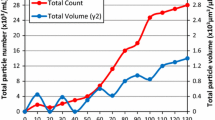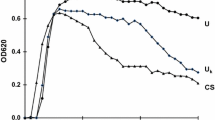Abstract
It is routinely observed that persons with increased urinary stone risk factors do not necessarily form uroliths. Furthermore, stone formers can present with urinalyses that do not reflect the clinical picture. We explain this discrepancy by differences in crystallization kinetics. In 1162 urines, crystallization of Ca-oxalate was induced according to the BONN-Risk-Index (BRI) method. The urine’s relative light transmissivity (RLT) was recorded from 100 % at start of titration to 95 % due to nuclei formation and crystal growth. From the RLT changes, a measure of the thermodynamic inhibition threshold of crystal formation (BRI) and of crystal growth kinetics is derived (“turbidity slope” after crystallization onset). On average, subjects presenting with a low inhibition threshold, i.e., high BRI, also present significantly higher crystal growth rates compared with subjects in lower BRI classes. Only subjects in the highest BRI class show a lower growth rate than expected, probably due to a depletion of supersaturation by massive initial nucleation. With increasing thermodynamic risk of crystal formation (i.e., increasing BRI) due to an imbalance between inhibitors and promoters of crystal formation, an increase in the imbalance between inhibitors and promoters of crystal growth (i.e., increasing growth rate) is observed. Both lead to an increased urolith formation risk. Healthy subjects with increased BRI are an exception to this trend: their urine is thermodynamically prone to form stones, but they show a kinetic inhibition preventing nuclei from significant growth.




Similar content being viewed by others
Abbreviations
- BRI:
-
BONN Risk Index
- CaOx:
-
Calcium oxalate
- COM:
-
Calcium oxalate monohydrate
- COD:
-
Calcium oxalate dehydrate
- NH4Ox:
-
Ammonium oxalate
References
Trinchieri A (2008) Epidemiology of urolithiasis: an update. Clin Cases Miner Bone Metab 5:101–106
Stamatelou KK, Francis ME, Jones CA, Nyberg LM, Curhan GC (2003) Time trends in reported prevalence of kidney stones in the United States: 1976–1994. Kidney Int 63:1817–1823
Romero V, Haluk A, Assimos D (2010) Kidney stones: a global picture of prevalence, incidence and associated risk factors. Rev Urol 12:86–96
Manthey DE, Teichman J (2001) Nephrolithiasis. Emerg Med Clin N Am 19:633–654
Nancollas GH (1982) Biological mineralization and demineralization. Springer, Berlin
Evan AP, Lingeman JE, Coe FL, Parks JH, Bledsoe SB, Shao Y et al (2003) Randall’s plaque of patients with nephrolithiasis begins in basement membranes of thin loops of henle. J Clin Invest 111:607–616
Lonsdale K (1968) Epitaxy as a growth factor in urinary calculi. Nature 217:56–58
Liebman M, Costa G (2000) Effects of calcium and magnesium on urinary oxalate excretion after oxalate loads. J Urol 163:1565–1569
Nicar MJ, Skurla C, Sakhaee K, Pak CYC (1983) Low urinary citrate excretion in nephrolithiasis. Urology 21:8–14
Kok DJ, Papapoulos SE, Bijvoet OL (1986) Excessive crystal agglomeration with low citrate excretion in recurrent stone-formers. Lancet 1:1056–1058
Schwille PO, Rumenapf G, Wolfel G, Kohler R (1988) Urinary pyrophosphate in patients with recurrent calcium urolithiasis and in healthy controls: a re-evaluation. J Urol 140:239–245
Ryall RL (1996) Glycosaminoglycans, proteins, and stone formation: adult themes and child’s play. Pediatr Nephrol 10:656–666
Worcester EM, Beshensky AM (1995) Osteopontin inhibits nucleation of calcium oxalate crystals. Ann N Y Acad Sci 760:375–377
Wesson JA, Johnson RJ, Mazzali M, Beshensky AM, Stietz S, Giachelli C et al (2003) Osteopontin is a critical inhibitor of calcium oxalate crystal formation and retention in renal tubules. J Am Soc Nephrol 14:139–147
Webber D, Rodgers AL, Sturrock ED (2002) Synergism between urinary prothrombin fragment 1 and urine: a comparison of inhibitory activities in stone-prone and stone-free population groups. Clin Chem Lab Med 40:930–936
Grover PK, Ryall RL (1999) Inhibition of calcium oxalate crystal growth and aggregation by prothrombin and its fragments in vitro: relationship between protein structure and inhibitory activity. Eur J Biochem 263:50–56
Kobayashi H, Shibata K, Fujie M, Sugino D, Terao T (1998) Identification of structural domains in inter-alpha-trypsin involved in calcium oxalate crystallization. Kidney Int 53:1727–1735
Atmani F, Khan SR (1999) Role of urinary bikunin in the inhibition of calcium oxalate crystallization. J Am Soc Nephrol 10(Suppl 14):S385–S388
Pillay SN, Asplin JR, Coe FL (1998) Evidence that calgranulin is produced by kidney cells and is an inhibitor of calcium oxalate crystallization. Am J Physiol 275:F255–F261
Hess B, Zipperle L, Jaeger P (1993) Citrate and calcium effects on Tamm-Horsfall glycoprotein as a modifier of calcium oxalate crystal aggregation. Am J Physiol 265:F784–F791
Knörle R, Schnierle P, Koch A, Buchholz NP, Hering F, Seiler H et al (1994) Tamm-horsfall glycoprotein: role in inhibition and promotion of renal calcium oxalate stone formation studied with fourier-transform infrared spectroscopy. Clin Chem 40:1739–1743
Smith R, Levine J, Rosenfeld AT (1999) Helical CT of urinary tract stones: epidemiology, origin, pathophysiology, diagnosis, and management. Radiol Clin N Am 37:911–952
Knoll T, Schubert AB, Fahlenkamp D, Leusmann DB, Wendt-Nordahl G, Schubert G (2011) Urolithiasis through the ages: data on more than 200,000 urinary stone analyses. J Urol 185:1304–1311
Moses R, Pais VM Jr, Ursiny M, Prien EL Jr, Miller N, Eisner BH (2015) Changes in stone composition over two decades: evaluation of over 10,000 stone analyses. Urolithiasis 43:135–139
Lieske JC, Rule AD, Krambeck AE, Williams JC, Bergstralh EJ, Mehta RA et al (2014) Stone composition as a function of age and sex. Clin J Am Soc Nephrol 9:2141–2146
Akin B, Oner M, Bayram Y, Demadis KD (2008) Effects of carboxylate-modified, green inulin biopolymers on the crystal growth of calcium oxalate. Cryst Growth Des 8:1997–2005
Kirboga S, Oner M (2009) Inhibition of calcium oxalate crystallization by graft copolymers. Cryst Growth Des 9:2159–2167
Milan A (2001) Crystal growth shape of whewellite polymorphs: influence of structure distortions on crystal shape. Cryst Growth Des 1:245–254
Zhang DB, Qi LM, Ma JM, Cheng HM (2002) Morphological control of calcium oxalate dihydrate by a double-hydrophilic block copolymer. Chem Mater 14:2450–2457
Echigo T, Kimata M, Kyono A, Shimizu M, Hatta T (2005) Re-investigation of the crystal structure of whewellite [Ca(C2O4)·H2O] and the dehydration mechanism of caoxite [Ca(C2O4)·3H2O]. Miner Mag 69:77–88
Hamm LL, Hering-Smith KS (2002) Pathophysiology of hypocitraturic nephrolithiasis. Endocrinol Metab Clin N Am 31:885–893
Spivacow FR, Del Valle EE, Negri AL, Fradinger E, Abib A, Rey P (2015) Biochemical diagnosis in 3040 kidney stone formers in Argentina. Urolithiasis 43:323–330
Amaro CR, Goldberg J, Damasio PC, Leitão VA, Turney B, Padovani CR, Amaro JL (2015) An update on metabolic assessment in patients with urinary lithiasis. World J Urol 33:125–129
Laube N, Kleinen L (2011) Risk indices. In: Rao NP, Preminger GM, Kavanagh JP (eds) Urinary tract stone disease. Springer, London, pp 355–368
Laube N, Hergarten S, Hoppe B, Schmidt M, Hesse A (2004) Determination of the calcium oxalate crystallization risk from urine samples: the BONN risk index in comparison to other risk formulas. J Urol 172:355–359
Kavanagh JP, Laube N (2006) Why does the bonn risk index discriminate between calcium oxalate stone formers and healthy controls? J Urol 175:766–770
Laube N, Berg W, Bernsmann F, Gravius S, Klein F, Latz S et al (2014) Induced urinary crystal formation as an analytical strategy for the prediction and monitoring of urolithiasis and other metabolism-related disorders. EPMA J 5:13
Laube N, Hergarten S (2005) Can the bonn risk index be replaced by a simple measurement of the urinary concentration of free calcium ions? J Urol 173:2175–2177
Porowski T, Zoch-Zwierz W, Wasilewska A, Spotyk A, Konstantynowicz J (2007) Normative data on the bonn risk index for calcium oxalate crystallization in healthy children. Pediatr Nephrol 22:514–520
Porowski T, Zoch-Zwierz W, Konstantynowicz J, Taranta-Janusz K (2008) A new approach to the diagnosis of children’s urolithiasis based on the bonn risk index. Pediatr Nephrol 23:1123–1128
Laube N, Pullmann M, Hergarten S, Hesse A (2003) Influence of urinary stones on the composition of a 24-hour urine sample. Clin Chem 49:281–285
Berg W, Bechler R, Laube N (2009) Analytical precision of the urolizer® for the determination of the BONN-risk-index (BRI) for calcium oxalate urolithiasis and evaluation of the influence of 24 h-urine storage at moderate temperatures on BRI. Clin Chem Lab Med 47:478–482
Berg W, Bechler R, Haas C, Laube N (2009) Relevance of the BONN risk index for metabolic monitoring of patients with calcium oxalate urolithiasis: a clinical application study of the urolizer. Urol Res 37:55–62
Coe FL, Parks JH, Nagakawa Y (1991) Protein inhibitors of crystallization. Semin Nephrol 11:98–109
Rodgers AL, Webber D, Hibberd B (2015) Experimental determination of multiple thermodynamic and kinetic risk factors for nephrolithiasis in the urine of healthy controls and calcium oxalate stone formers: does a universal discriminator exist? Urolithiasis 43:479–487
Türk C, Knoll T, Petrik A, Sarica K, Skolarikos A, Straub M, Seitz C (2015) Guidelines on urolithiasis. Eur Assoc Urol. http://uroweb.org/wp-content/uploads/22-Urolithiasis_LR_full.pdf. Accessed 10 May 2016
Author information
Authors and Affiliations
Corresponding author
Ethics declarations
Conflict of interest
The authors declare that they have no conflict of interest. None of the employers played any role in the study design, in the collection, analysis, and interpretation of data, in the writing of the report or in the decision to submit the report for publication.
Rights and permissions
About this article
Cite this article
Laube, N., Klein, F. & Bernsmann, F. Kinetics of calcium oxalate crystal formation in urine. Urolithiasis 45, 151–157 (2017). https://doi.org/10.1007/s00240-016-0900-y
Received:
Accepted:
Published:
Issue Date:
DOI: https://doi.org/10.1007/s00240-016-0900-y




